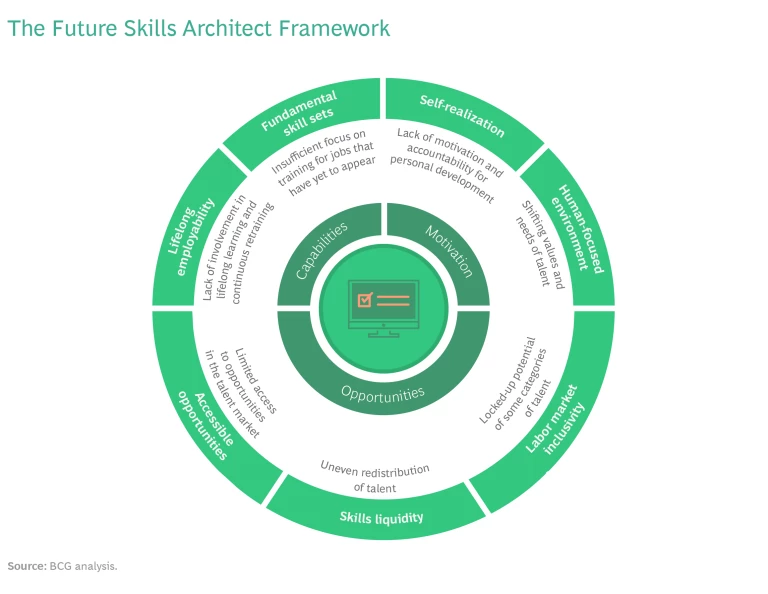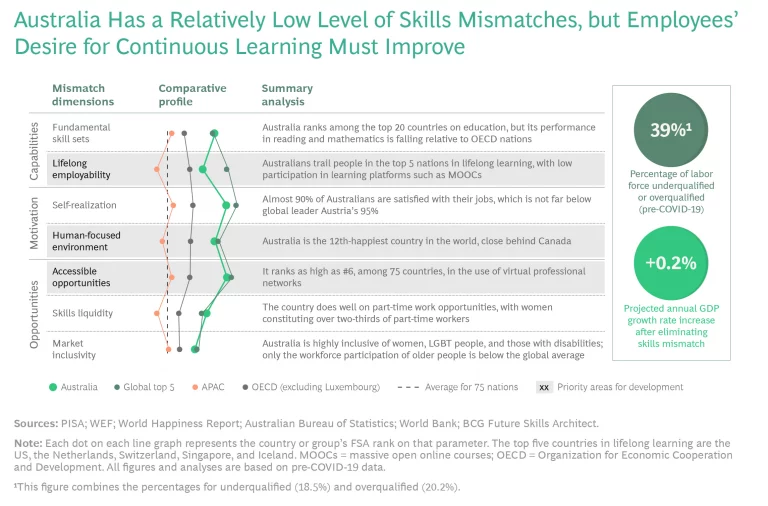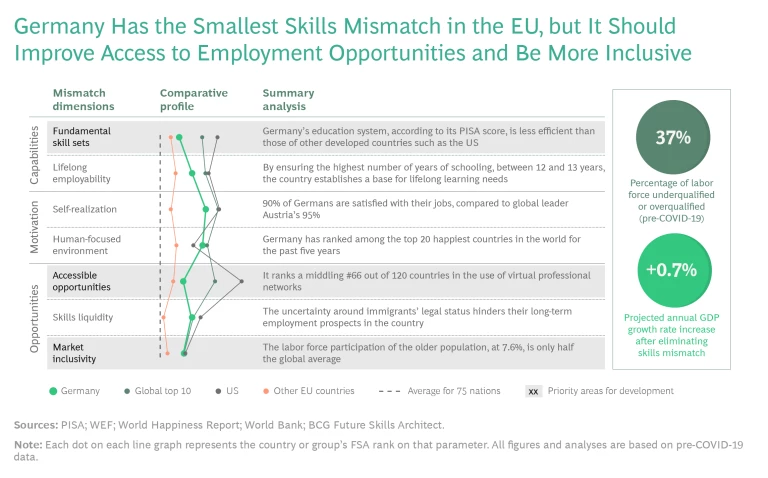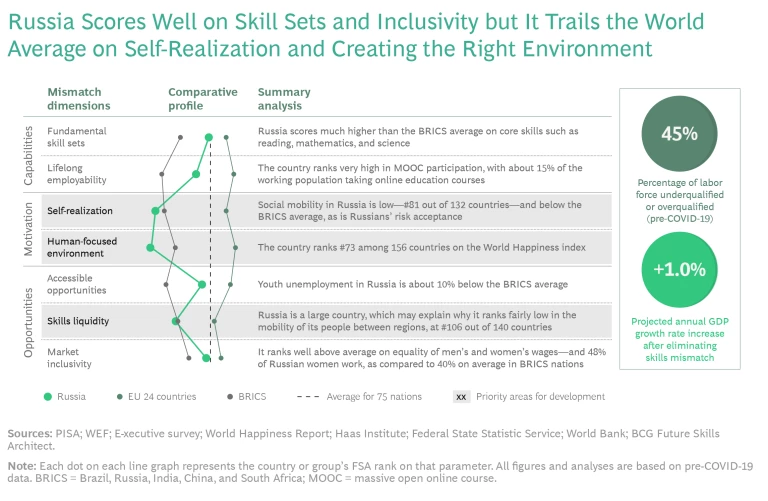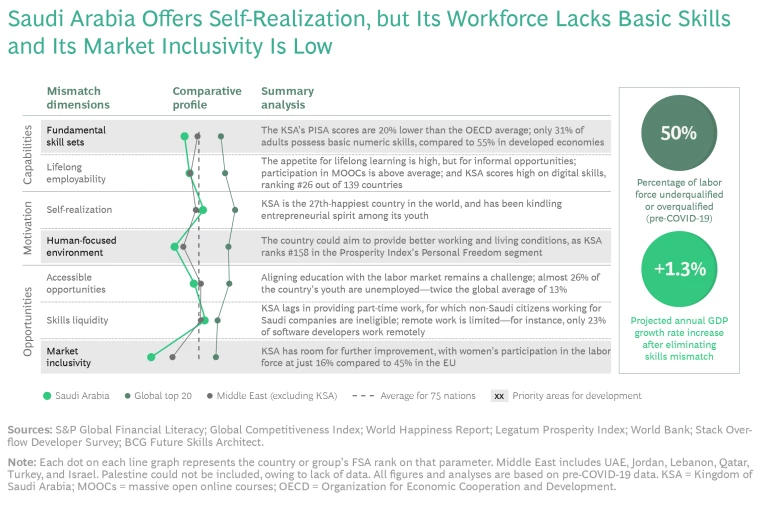By using a tool called the Future Skills Architect, government and business in any country can uncover the many factors underlying the skills mismatch, and adopt strategies to reskill and enable the workforce for the future.
It’s difficult to architect the skills for a fast-changing future without a blueprint. As countries around the world struggle to overcome the COVID-19 pandemic and the economic paralysis it has forced, the crisis has thrown a major workforce-related issue into sharp relief. Although governments are pulling out all the stops to fight the economic slowdown, job losses are mounting, unemployment is rampant, and incomes are tumbling. While the rehiring of workers by business may stoke the labor market’s recovery in the months ahead, many layoffs seem likely to become permanent.
Numerous countries face a fundamental skills-related problem, particularly because the nature of the skills necessary in the future has abruptly changed since the pandemic began. The rising degree of digitization, the need to work remotely, and the pace of automation have compounded the challenges of developing a workforce capable of building the new reality. In fact, countries must deal with both a traditional skills gap—the unavailability of enough candidates with the skill sets needed to fill vacancies—and a skills mismatch, in which people’s qualifications aren’t the ones needed for the jobs they do.
Overcoming the skills mismatch, it turns out, is tougher than dealing with the skills gap. In today’s turbulent talent market, employers are struggling to find people who have the skills and experience they need. As a result, they are hiring underqualified or overqualified people and then retraining them. The mismatch issue has grown over time. One telling indicator: Even before the COVID-19 pandemic erupted, data showed that one in three people in the OECD countries was working in an occupation completely unrelated to his or her field of study—and not by choice.
Responding to the skills mismatch should therefore be at the top of every country’s human capital development agenda. It’s a complex problem, though, and identifying the underlying causes is critical to solving it. In this article, we unveil an evidence-based tool, the Future Skills Architect, designed to help policymakers and business leaders uncover instances of the skills mismatch in their economies and figure out the ways to deal with them.
The Skills Mismatch Is Costly
Both governments and businesses tend to overlook the skills mismatch. People who work in jobs for which they aren’t trained or in which their skills are underutilized go unrecognized in official counts of the unemployed. According to our research, however, more than 1.3 billion people globally work in jobs for which they are either underqualified or overqualified.
The skills mismatch exacts a heavy toll on the world economy. In 2018, it cost the world economy $8 trillion in unrealized GDP—a 6% productivity loss or tax, as we call it—and we project that figure to rise to 10% of GDP by the end of 2020. The global economy can ill afford to bear a burden of that magnitude, especially after the havoc that COVID-19 has wrought. Looking further out, the best-case scenario in a post-COVID-19 world is a loss of around 8% a year by 2025, whereas the worst case is an opportunity cost of 11% of GDP by 2025. That’s $18 trillion—equal to the entire European Union’s GDP in 2018.
The skills mismatch has several second-order effects as well. Our studies show an inverse correlation between the skills mismatch and productivity, innovation, and even sustainable development. The higher the degree of skills mismatch in a country, the lower the country tends to score on the Global Talent Competitiveness Index, the Global Innovation Index, and the UN Sustainability Goals.
Skills Development Rests on Three Pillars
Tackling the skills mismatch requires a nuanced understanding of the policies and practices governing a country’s labor market. As policymakers consider their arsenal of strategies, they should ask themselves four questions:
- How relevant is our country’s skills inventory to its current and future economic needs?
- Does our country’s work environment attract talent and motivate people to work?
- How efficient are our labor market’s skill-matching mechanisms?
- How willing are workers to find better professional opportunities?
Answering those questions will enable policymakers and decision makers to identify the problem’s causes. Governments must address three pillars—capabilities, motivation, and opportunities—that underpin the creation of a vibrant and productive workforce. By focusing on these core areas, a country can reduce the skills mismatch, increase productivity, and improve its ranking on several metrics. According to our simulations, a 10% increase in ranking would result in as much as a 1% increase in a nation’s GDP.
To realize such gains, however, governments must trace the root causes of the skills mismatch and adopt innovative policy measures to tackle them. To help with this process, we’ve developed a tool that we call the Future Skills Architect (FSA). It consists of a country maturity assessment process, the FSA Maturity Index; a national goal-setting model; and a library of about 50 plug-and-play solutions, such as government policies and market-based instruments, to use in dealing with mismatch-related issues. The FSA Maturity Index is based on 59 indicators for 75 countries—grouped into five categories by income—that together account for approximately 95% of the world’s GDP and 79% of its population. In addition to providing global and regional indices, the FSA database offers benchmarks for comparing the skills mismatch and skills-related parameters in different countries.
This instrument assesses seven building blocks related to capabilities, motivation, and opportunities (see the exhibit):
- Fundamental Skill Sets. Governments, business, and educational institutions must find ways to help people develop skills that will enable them to perform present-day jobs and jobs that don’t yet exist.
- Lifelong Employability. Today, skills become obsolete quicker than they did in the past, which makes reskilling and upskilling necessary. Governments and business must ensure that opportunities for lifelong learning are available and that people understand the need to commit themselves to continuous learning and retraining.
- Self-Realization. Governments and business must inculcate the needed motivation and accountability in people for their personal development by offering the right incentives and education.
- Human-Focused Environment. Planners and HR specialists must understand the specific needs, values, and demands of talent, whose knowledge, skills, experiences, and ambitions differ greatly from one generation to another.
- Accessible Opportunities. Governments and business must ensure that information about and access to opportunities are open to every potential employee nationally and even globally.
- Skills Liquidity. Decision makers must ensure that people outside a job’s immediate location apply for it, to enlarge the candidate pool for every job and to give every candidate access to a larger pool of jobs. That might seem likely to happen naturally in a post-COVID-19 world, where remote work has become the norm, but government policies—especially those relating to immigration—and company practices must change a great deal to widen the talent pool for each position.
- Labor Market Inclusivity. Policymakers and business leaders must figure out how to unlock the potential of all kinds of labor in the economy, including older workers and the disabled.
By using the FSA instrument, a government can uncover many factors underlying the skills mismatch in its country and can adopt strategies to reskill and enable the workforce. As our analyses of Australia, Germany, Russia, and Saudi Arabia indicate, countries could substantially boost their GDP growth rates by eliminating the skills mismatch. (See the appendix.) Moreover, the current estimates represent conservative pre-COVID-19 projections. If governments can use the crisis to convince people to rethink their aspirations, reskill themselves, and seek jobs better suited to their skills, the positive impact on economic growth of eliminating the skills mismatch could almost double.
The FSA is a versatile instrument that a government can use in various ways:
- Conduct health checks. Decision makers can ask: How effective have we been in tackling the underlying causes of the skills mismatch? What additional policy actions should we take?
- Perform benchmarking. They can ask: What are comparable countries or regions doing to solve their skills mismatch problem? What policy measures are they using? Are we deploying them too? If not, why not?
- Promote effective adaptation. The government can experiment and adopt best practices. Decision makers can ask: How can we adapt a solution that has been successful in another country or region, so that it will work in our economy too?
At a micro level, leaders of different institutions can use the FSA to tackle specific issues related to the skills mismatch. For instance, it can help leaders of national or regional governments decide what policy instruments they should deploy; assist a CEO in conducting a health check of employees’ skills and determining what measures are needed to develop them further; and assist a university leader in figuring out how to boost the institution’s productivity and value to the economy.
Best Practices for Resolving Short- and Long-Term Mismatch Issues
A few governments are already pursuing policy measures to counteract the pandemic’s impact and, at the same time, address the skills mismatch in their countries. They’ve taken immediate steps to avoid additional deterioration of their labor markets, created midrange programs focused on eliminating labor market distortions, and begun developing policies to unlock the full potential of human capital. Three practices in BCG’s library merit discussion.
Deploy digital talent-matching platforms. Many governments, industries, and companies have tapped into the power of online talent platforms to mitigate the skills mismatch and make it easier for businesses to find the skills they need. Several platforms that were created to help employees face the consequences of COVID-19 are also helping employers tackle the skills mismatch by giving them access to prescreened talent pools. For example, Australia’s Hatch Exchange was designed to serve as a platform to connect university students to part-time jobs, but it responded to the crisis by switching quickly to matching companies that had openings with people who needed jobs. More than 70 companies signed up with Hatch, and it helped redeploy over 500 “stood-down” workers, some within 72 hours of applying.
Similarly, Beremnarabotu.ru, an online platform set up by Sberbank, has helped many people in Russia find work during the COVID-19 pandemic. Its first user, Sbermarket, used the platform to add 10,000 couriers in April 2020 alone. In the US, ServiceNow joined with Accenture, Lincoln Financial Group, and Verizon to launch People + Work Connect in April 2020. An analytics-based platform, People + Work enables companies to share the experiences and skills of furloughed and laid-off workers with organizations seeking talent. It’s free to use, although only employers with 100 or more jobs to fill or employees to place can sign up for it. More than 250 companies—including Baxter, Marriott, Mondelēz, and Wal-Mart—have already signed up and used the platform.
Facilitate remote skills development. Governments, especially in developing countries, have a critical need to augment the supply of trained talent by reducing entry barriers in the labor market. One way to do that is to ride the global wave of online education necessitated by the COVID-19 crisis—but to do so with an eye open to the future.
In Jordan, for example, the government launched Darsak, an online platform for school education, in March 2020. This e-learning platform provides free lessons in Arabic and English for all public school students in grades 1 through 12, including the Tawjihi (Grade 12) secondary education certificate examination. The daily lessons—which consist of video clips recorded by the country’s best teachers—are also broadcast on national TV for households that lack internet access.
Mawdoo3.com, one of the largest Arabic platforms in the world, joined forces with Jordan’s Ministry of Education, its Ministry of Digital Economy and Entrepreneurship, and Amazon Web Services to develop the platform. Three content providers—Abwaab, an online learning platform; Jo Academy, an e-learning platform; and Edraak, a nonprofit, open online course portal—helped develop the content. The consortium developed Darsak in just a week, with Jordan’s telcos giving children free connectivity to the platform.
Meanwhile, in India, the government recently allowed 100 top universities to offer online-only degrees for the first time. In addition, the state-run online education platform, Swayam, launched 1,900 online courses on topics ranging from engineering and robotics to computer programming and biotechnology, to support students during the lockdown. Each course consists of video lectures, downloadable or printable reading materials, self-assessment tests and quizzes, and an online discussion forum. The courses are free, but students who want to earn a certificate must pay a fee to take the exam.
Use the lockdown to induce people to reskill and upskill. A few governments have used the economic paralysis of the COVID-19 crisis to catalyze the upskilling of talent. Doing this will help them get ahead of the curve once business rebounds.
Many countries are making skills-related information more readily available, so people can make informed choices about reskilling themselves and launching new careers. In some countries, such as Canada, the government is working with employers. Canada’s $100-million PACME program provides financial support to businesses that are reskilling employees online, for instance. Companies have been using the funds to improve workforce skills and to prepare for the recovery.
Other governments focus on employees, especially those out of a job. For example, as part of its COVID-19 Higher Education relief package, the Australian government has been subsidizing unemployed workers who take short online courses. It also provides a six-month exemption from loan fees and has set aside $18 billion for students and $100 million for education providers.
Similarly, Singapore’s Skills Future Credit program encourages individuals to own skills development and lifelong learning. In addition to gaining a standard credit of S$500, people who are over 25 years old and working in sectors affected by the crisis have received a further S$500 this year, and those who are 40 to 60 years old have received an extra S$1,000. They can use the money to enroll in any of the 8,000-plus courses offered by Singapore’s institutes of higher learning and its confederation of trade unions, the National Trades Union Congress.
Grim though the current health and economic crisis may be globally, it has served as a clarion call for governments and businesses to rethink and invest in reskilling strategies. The stubborn persistence of the skills mismatch raises questions about the relevance of a nation’s skills inventory to its current and future needs, the effectiveness of the labor market’s skill-matching mechanisms, and the socioeconomic environment’s ability to attract talent and encourage self-realization through work. Governments and businesses need to work together not just to tackle today’s short-term challenges such as retention and redeployment, but also to rebuild people’s skills and capabilities to meet future needs.
Although this has not been a traditional practice, governments across the world would do well to start treating national education policies and labor policies as key elements of an ecosystem. Many countries keep them separate, on the misplaced assumption that mixing education with work makes pursuit of the former somehow less noble. The fact is, however, that education’s outputs are the workforce’s inputs. Tweaking supply to respond to demand is essential to improving the efficiency of both—and that should be the goal of policy and practice.
As in any ecosystem, exchanging best practices is important, especially given the scale of the problem and the speed at which it needs to be solved in a fast-changing world. All levels of government will benefit from collaborating to tackle this vexing issue. No single initiative is likely to achieve the same results everywhere, so policymakers must understand how local contexts and needs shape policies before introducing them. Only by responding to the skills mismatch challenge with a multipronged approach to reskilling and upskilling can policymakers and business leaders ensure that their economies recover from the current crisis and, over time, rebound into the future as people fully utilize their capabilities in the jobs they do.

